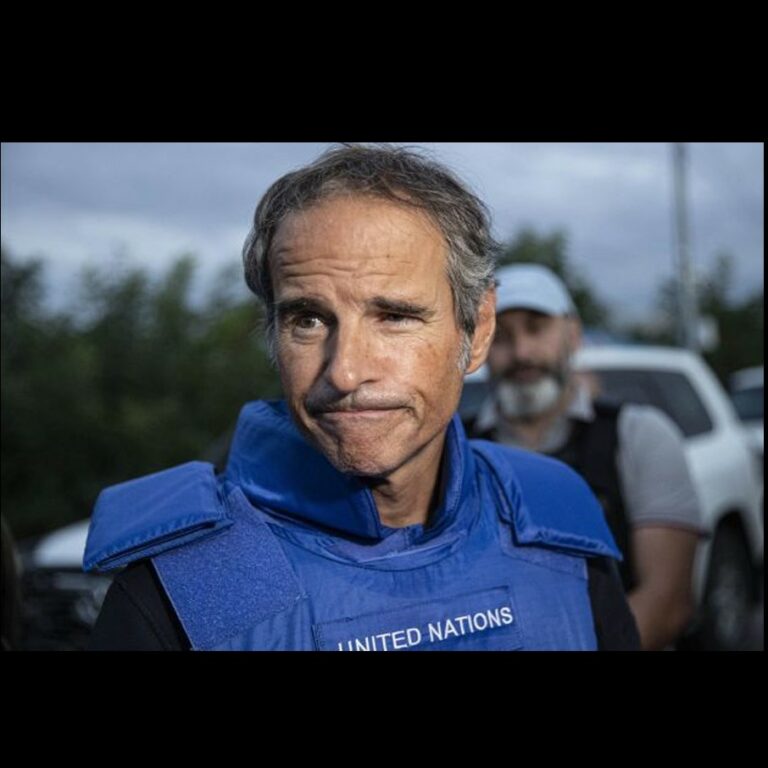
For over a year, the Zaporizhzhia Nuclear Power Plant, the largest nuclear power plant in Europe, has been occupied by Russian forces. Humanity has been on the brink of a nuclear catastrophe for over a year. This is the first instance in the world where one country’s military has seized another’s nuclear power plant. And not just captured but militarized the plant, terrorizing its personnel and shelling neighbouring cities from its territory. In connection with this, Ukrainians are increasingly hearing about the International Atomic Energy Agency (IAEA) – an international organization supposed to oversee nuclear energy use solely for peaceful purposes. How does it operate during wartime, and can it fulfil its functions under such circumstances?
Together with energy policy expert Artem Kolesnyk from the NGO Ecodia, we will delve into how the IAEA was formed and functions and what obligations Ukraine fulfils towards this international organization. We will also explore the gaps in the IAEA’s work that have been evident over the past decades and examine how the agency is responding to the security situation surrounding Ukrainian nuclear power plants.
What is the IAEA?
The IAEA aims to promote the peaceful use of nuclear energy, seeking to ensure that nuclear technology is not applied for military purposes. The need for such an agency emerged in the early 1950s, when nuclear technologies were rapidly advancing, and memories of the atomic bombings of Hiroshima and Nagasaki were still fresh.
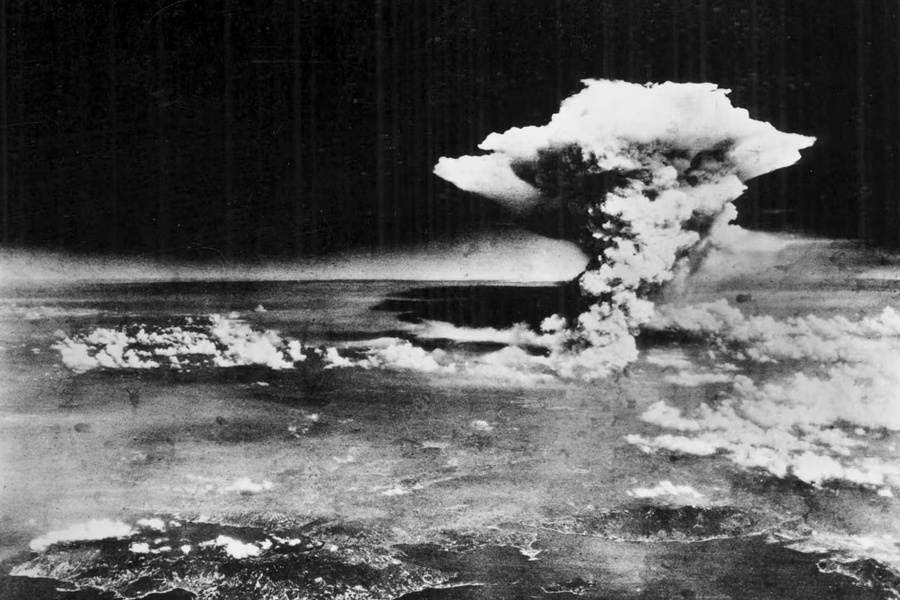
A photo taken by the US military and provided by the Hiroshima Memorial Museum. Photo: ERA.
In 1953, foreseeing the future nuclear arms race, U.S. President Dwight D. Eisenhower delivered a speech titled “Atoms for Peace” at the United Nations. He proposed the creation of an organization focused on supporting the technologies of the “peaceful atom.” His vision was realized in the form of the IAEA, which began operating in 1957 as an autonomous intergovernmental agency under the auspices of the United Nations.
According to its Statute, the two primary objectives of the IAEA’s activities are the peaceful use of atomic energy and ensuring that the agency’s assistance is not used for military purposes. The IAEA provides advice and practical assistance to governments of various countries in implementing atomic energy programs. The main goal of these programs is to facilitate the transfer of skills and knowledge, enabling countries to implement atomic programs more effectively and safely. The agency offers advisors and equipment and provides training for specialists. It played a crucial role in addressing the consequences of the Chornobyl accident at the Chornobyl Nuclear Power Plant in Ukraine in 1986, significantly complicating the organization’s primary mission of advancing nuclear energy use.
Currently, the IAEA includes 175 member countries. According to its Statute, any state can become a member of the agency regardless of its membership in the United Nations. Members are approved by the Board of Governors and the General Conference, provided the candidates are willing and able to act in accordance with the principles of the United Nations and fulfil their obligations to the IAEA.
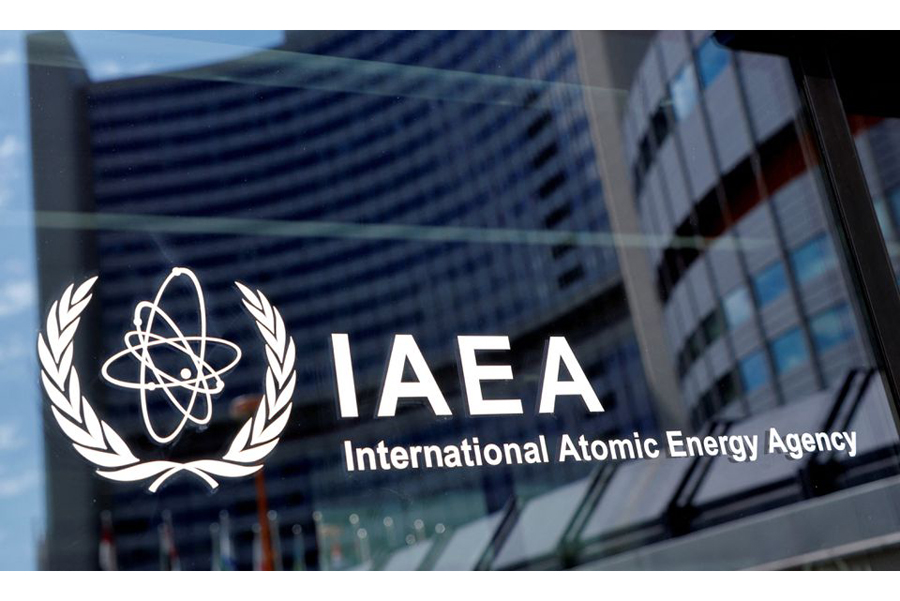
The IAEA emblem. Photo from open sources.
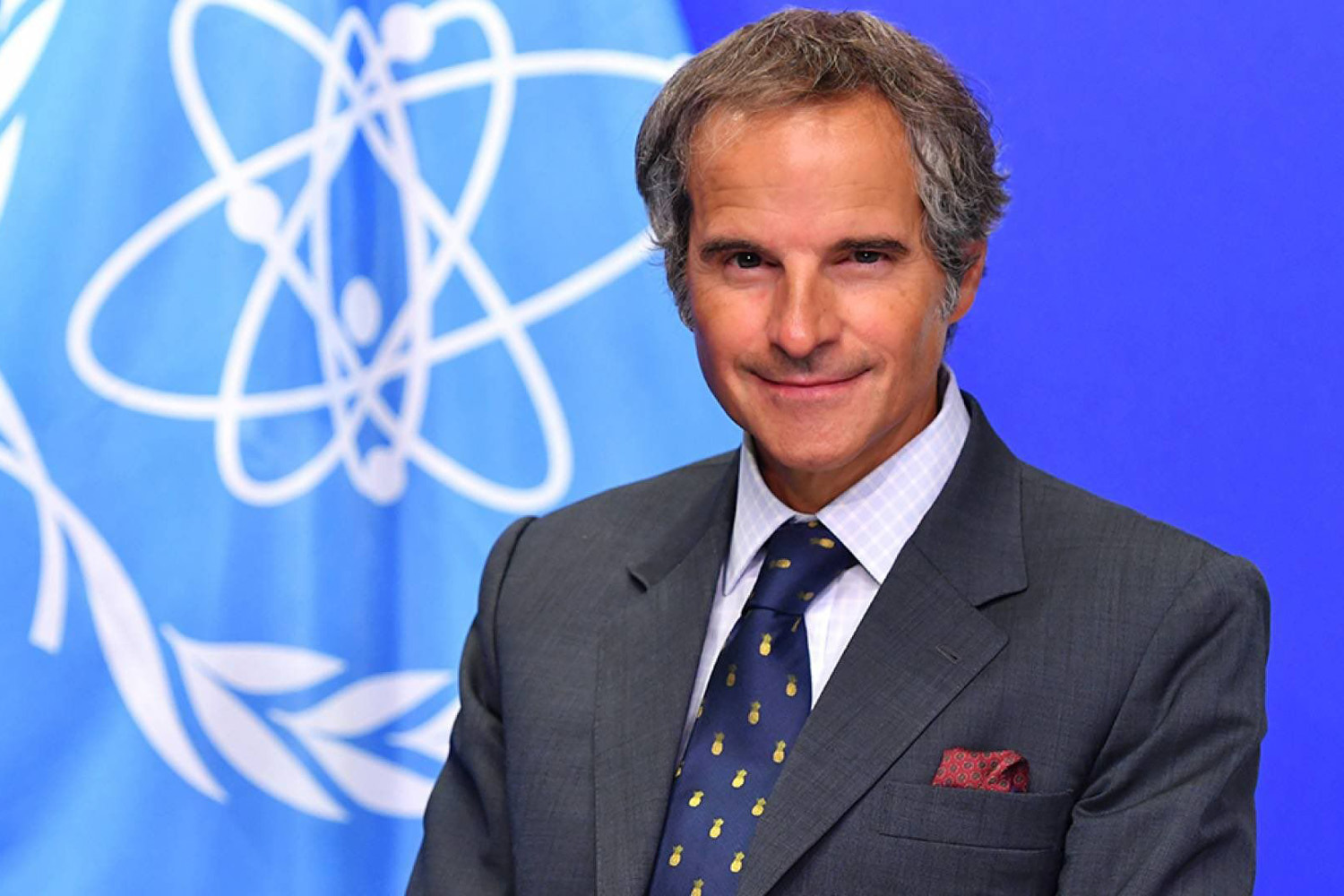
IAEA Director General Rafael Grossi. Photo: Twitter.
The IAEA operates primarily at the cost of contributions from member states. For instance, in 2022, its budget amounted to 390 million euros. The contribution size is defined based on a country’s financial capacity, but none can exceed 22% of the total budget.
How relations between Ukraine and the IAEA have been shaped
After the dissolution of the USSR, Ukraine possessed the third-largest nuclear arsenal in the world. However, it agreed to renounce its nuclear weapons by signing the Budapest memorandum, and the signatory countries (including Russia) were to respect Ukraine’s independence, sovereignty, existing borders and refrain from any acts of aggression against Ukraine, including economic pressure. Ukraine laid out its position on the nuclear weapons on its territory in the Declaration of State Sovereignty and in the Statement of the Verkhovna Rada (Ukrainian Parliament) “On Ukraine’s non-nuclear status.”
Budapest Memorandum
is an international agreement signed by Ukraine, Russia, the United Kingdom, and the United States on guarantees for Ukraine concerning its entry into non-nuclear status.In 1992, Ukraine and Russia signed the Agreement on the Transfer of Nuclear Weapons. In 1994, Ukraine, the U.S., and Russia signed a Trilateral Statement facilitating Ukraine’s accession to the Treaty on the Non-Proliferation of Nuclear Weapons.
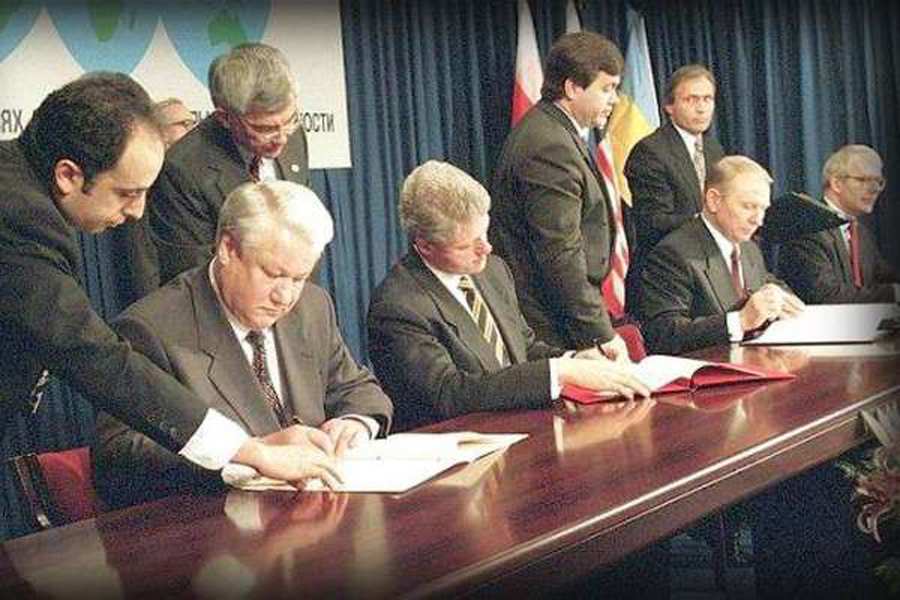
The signing of the Budapest Memorandum. Photo: Wikipedia.
The displacement of Ukraine’s strategic nuclear warheads was completed by June 1996. According to the “Law of Ukraine on the Accession of Ukraine to the Treaty on the Non-Proliferation of Nuclear Weapons” (1994), Ukraine became a non-nuclear state and renounced the production and acquisition of nuclear weapons. Thus, Ukraine recognized the potential threat of the expansion of the “nuclear club” and continues to work towards preventing the proliferation of nuclear weapons.
Nuclear Club
is an informal term for a group of countries possessing nuclear weapons. It includes the United States, Russia, the United Kingdom, France, China, India, Pakistan, North Korea, and unofficially, Israel.After eliminating its nuclear arsenal, Ukraine signed an agreement with the IAEA, which guaranteed the agency access to information about the disposition of its nuclear materials (nuclear fuel, nuclear waste, etc.). The State Nuclear Regulatory Inspectorate of Ukraine is accountable for coordinating cooperation between Ukraine and the IAEA per this Agreement and its Additional Protocol. The state regulatory authority performs the following:
– Collection, processing, analysis, and provision of the IAEA with information received from the state bodies responsible for accounting and control of nuclear materials;
– Determination and coordination with the IAEA the location zones and state accounting of nuclear materials;
– Addressing issues of interaction with the IAEA on matters related to the implementation of international agreements, including contentious issues;
– Informing the state system for accounting and control of nuclear materials about any notifications from the IAEA regarding inspections or additional visits under international agreements.
By fulfilling the requirements of the Agreement on Guarantees and its Additional Protocol, Ukraine fulfils its obligations regarding nuclear non-proliferation and utilizes atomic energy solely for peaceful purposes.
Limitations of the IAEA
According to the Treaty on the Non-Proliferation of Nuclear Weapons, the IAEA is tasked with verifying the compliance of its participants with their obligations. However, the agency does not have direct authority to influence its members. The IAEA can only monitor and facilitate the fulfilment of commitments by member states following the Treaty. The agency inspects the nuclear facilities of these countries, including power plants, research centres, and enrichment facilities, to ensure that governments are not producing nuclear weapons, and it controls radioactive materials to prevent their misuse by third parties.
However, it does not always succeed. The IAEA cannot impose sanctions on countries that violate their obligations as it relies solely on the voluntary willingness of states to cooperate. If a country refuses, the IAEA lacks the tools for enforcement. As a result, the enforcement of the Treaty and the implementation of measures against violators remain in the credentials of the United Nations and each participating state, which may resort to political and economic measures to respond to such breaches.
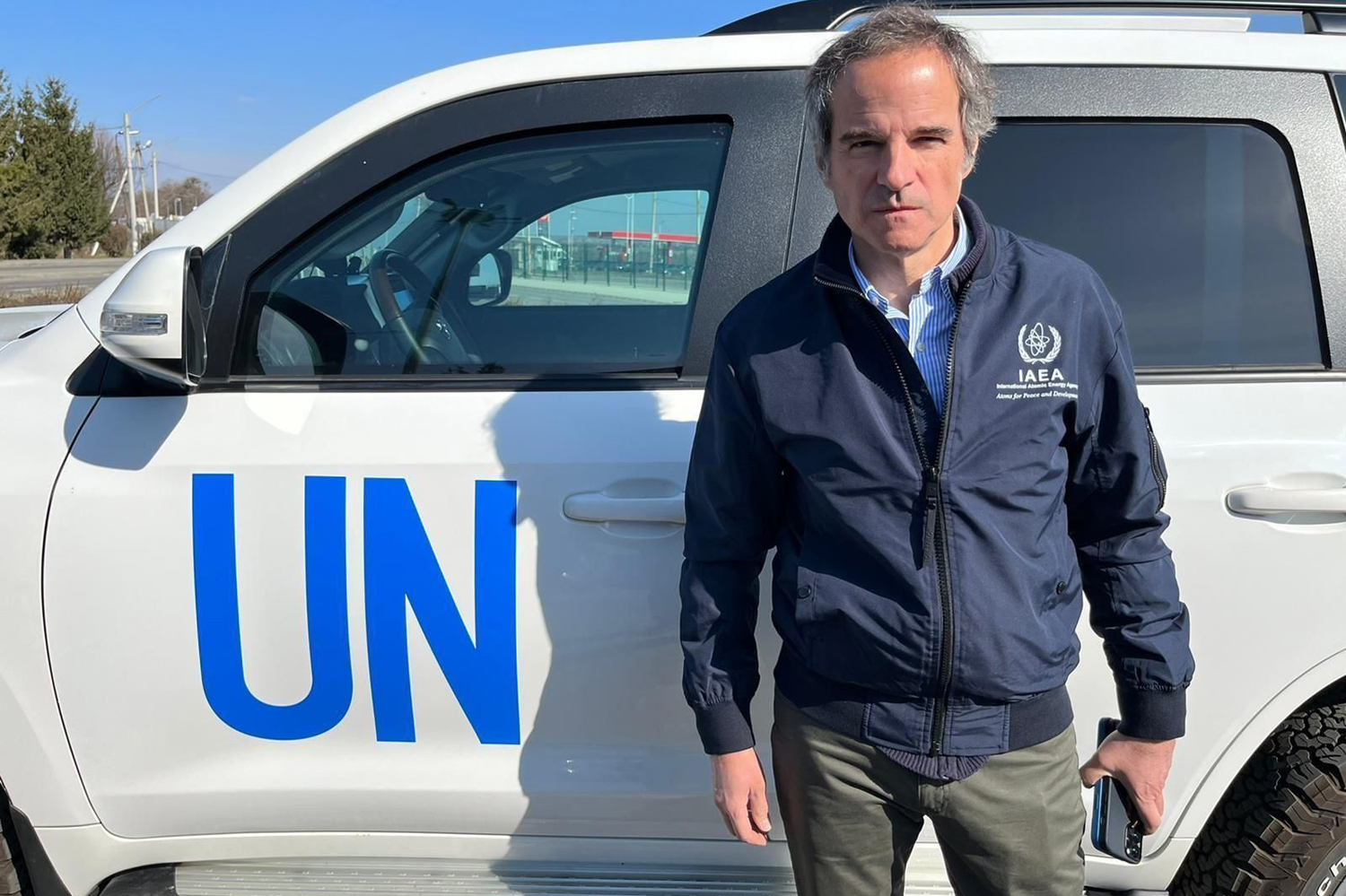
IAEA Director General Rafael Grossi in Ukraine, 29 March 2023. Photo: Twitter.
The problem became evident in 2002 when North Korea expelled IAEA inspectors, preventing the agency from monitoring nuclear activities in Pyongyang.
Israel, believed by analysts to possess nuclear warheads, never signed the Nuclear Non-Proliferation Treaty and thus is not subject to IAEA monitoring. India and Pakistan, both nuclear-armed states, also aren’t signatories to the treaty. Hence, the agency is unable to conduct inspections.
The IAEA was also expected to play a crucial role in ensuring Iran’s compliance with commitments outlined in the Joint Comprehensive Plan of Action (JCPOA), a nuclear agreement established in 2015. However, one of the main issues was Iran’s refusal to grant access to specific sites, which it considers “military zones,” citing national security. Another problem is Iran’s periodic violations of its obligations to the IAEA. For instance, the country announced an increase in uranium enrichment beyond the limits of the Iran Nuclear Deal. This could indicate the potential illicit development of nuclear weapons in the country.
JCPOA (Joint Comprehensive Plan of Action)
is a nuclear agreement signed in Vienna between Iran, the five permanent members of the United Nations Security Council (USA, Russia, China, France, the United Kingdom), as well as Germany and the EU, regarding Iran's nuclear program.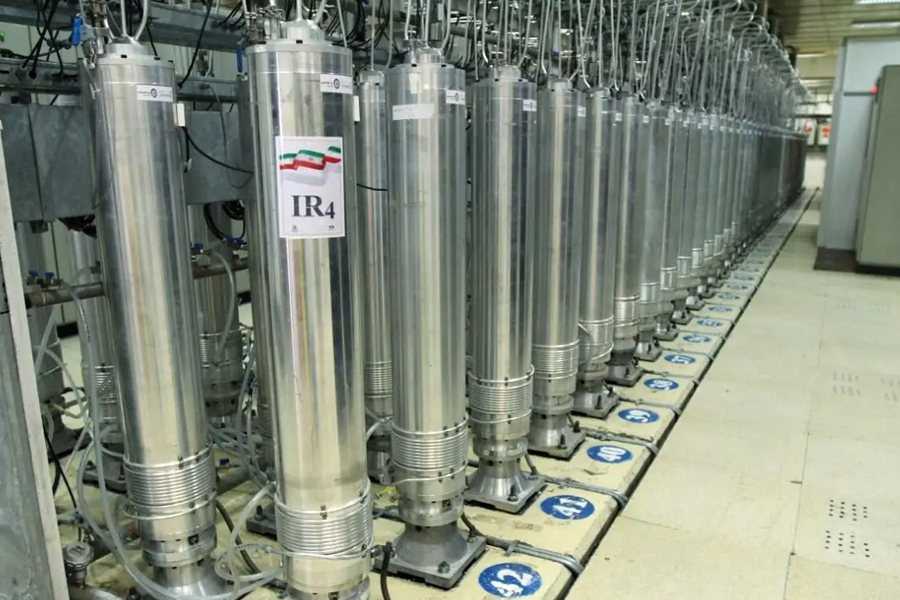
Centrifuges used for uranium enrichment at Iran's Natanz nuclear fuel production plant. Photo: Iranian media.
The post-accident situation in Fukushima triggered severe criticism of the IAEA role. The organization was accused of delaying and distorting the truth about radiation levels and the actual consequences of the disaster. This led to a loss of public trust in the IAEA and raised doubts about its independence and objectivity. The organization did not ensure proper transparency in presenting information about potential health consequences. It attempted to reassure the global community, and it downplayed the severity of the issue by omitting or downplaying certain facts. The mistrust in the IAEA resulted in the growing popularity of alternative, independent research groups, such as Greenpeace. These groups sought to fill the information gap to provide the global community with credible data regarding radiation hazards and the consequences of the accident.
Rafael Grossi in Japan. Photo: Eugene Hoshiko/Pool AP.
In August 2019, an explosion near Arkhangelsk, Russia, resulted in the deaths of five people (according to official statistics), with an additional two later succumbing to acute radiation sickness and four others receiving significant doses of radiation. According to U.S. intelligence, the explosion was caused by lifting the nuclear-powered cruise missile “Burevestnik” from the seabed. After the incident, two barges, presumably used to transport remnants of the missile, were left on the shores of the White Sea near the village of Nyonoksa for several months. The background radiation at the location where the radioactive barges were reached 700 micro roentgen per hour, exceeding permissible norms by 14 times. Despite this, the IAEA did not include information about this explosion in its annual report.
By the way, concerning Russian influence on the IAEA. the Soviet Union was among the 12 countries that co-founded and developed the agency’s statute. Since 1991, the Russian Federation has declared itself the successor to the USSR in all UN bodies and has taken its place. Since the beginning of 2018, Russia has contributed 3% to the IAEA’s budget. One of the deputy directors of the IAEA is a Russian, which gives this country some influence over critical organizational decisions. This is Mikhail Chudakov, who heads the Department of Nuclear Energy. He worked in “Rosatom” and can access information about Ukrainian nuclear power plants. His connections with Russian political figures and cooperation with occupying forces make him controversial.
State corporation Rosatom
is a Russian state holding company that includes all civilian nuclear companies in Russia, nuclear weapons complex enterprises, research organizations, and the nuclear icebreaker fleet.Another Russian in the IAEA is Mikhail Ulyanov, Russia’s permanent representative to international organizations in Vienna. He expressed an anti-Ukrainian stance on his Twitter account, writing, “No mercy for the Ukrainian population!” He was also one of the organizers of the first IAEA commission visit to the Zaporizhzhia Nuclear Power Plant.
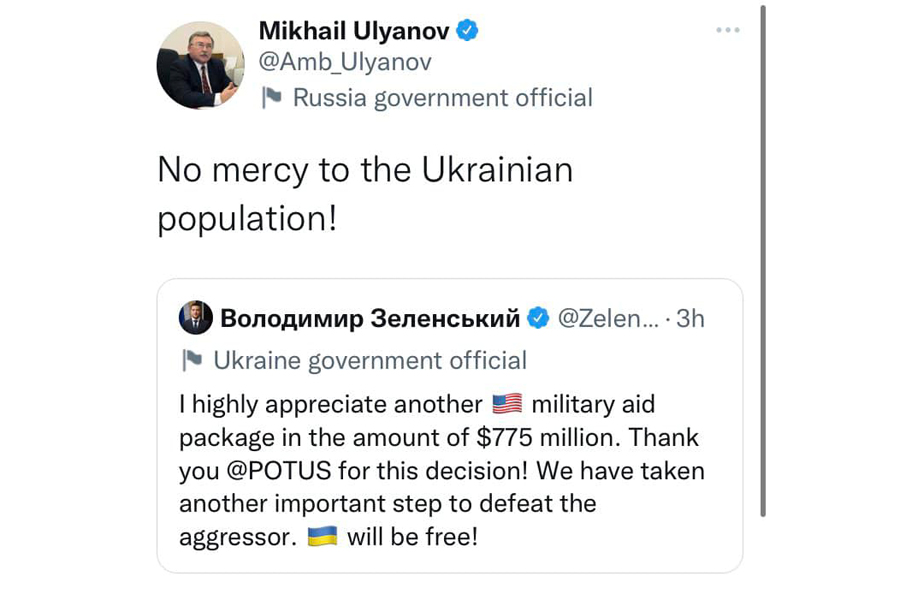
A tweet by Mikhail Ulyanov.
IAEA’s Reaction to the Russian Threat to Ukrainian Nuclear Facilities
According to the results of radiation level research conducted by the international environmental organization Greenpeace in the Chornobyl Exclusion Zone, radiation levels in certain areas where Russians were stationed during the Chornobyl NPP occupation significantly exceed the estimates provided by the IAEA. This raises doubts about the effectiveness of the organization and the credibility of the information it presents.
On the night of March 3-4, 2022, humanity witnessed the first case in world history where one country’s military attacked and seized another’s operational nuclear power plant. As a result of these actions, the Zaporizhzhia Nuclear Power Plant (ZNPP) sustained significant damage and experienced fires, leading to the shutdown of most of its reactor units. Despite the presence of Russian forces, the plant’s personnel maintained its operational capability and safety. All of these events pose a serious threat to the nuclear safety of the region and could potentially trigger a new technogenic ecological and humanitarian disaster.
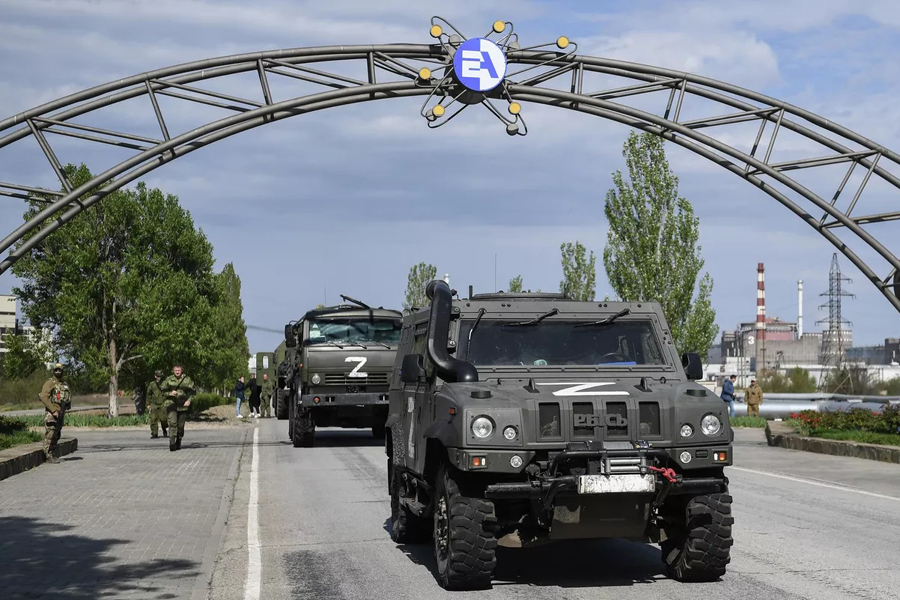
Military equipment of the Russian occupiers on the territory of the ZNPP. Photo: Defence express.
In March 2022, the Director-General of the IAEA stated the necessity of allowing an agency’s commission to access Ukrainian nuclear power plants. However, the process was delayed due to Russia’s demands and the exclusion of representatives from the United States and the United Kingdom from the commission. The IAEA had claimed that the commission was formed by “predominantly neutral countries.” Nonetheless, individuals with Russian passports were included in the commission, which created difficulties for their visit to the occupied nuclear power plant as they were supposed to travel through Ukrainian-controlled territory.
In June 2022, the IAEA prohibited Ukrainian representatives from presenting a report on radiation sources in the Joint Forces Operation area at a conference. Mention of the reasons for conducting such radiation source checks appeared inappropriate to the organizers’ intended conference purpose. The IAEA’s scientific secretariat also recommended removing references to the situation (effectively referring to Russia’s military aggression) that emphasized the need for radiation source checks in eastern Ukraine. Meanwhile, Russian representatives were prominently present. This naturally raises questions about the IAEA’s objectivity towards Ukraine.
JFO
The Joint Forces Operation was a complex of military and organizational-law measures by Ukrainian security forces that took place from April 2018 to February 24, 2022. It aimed to counter illegal Russian and pro-Russian armed formations in the war in eastern Ukraine.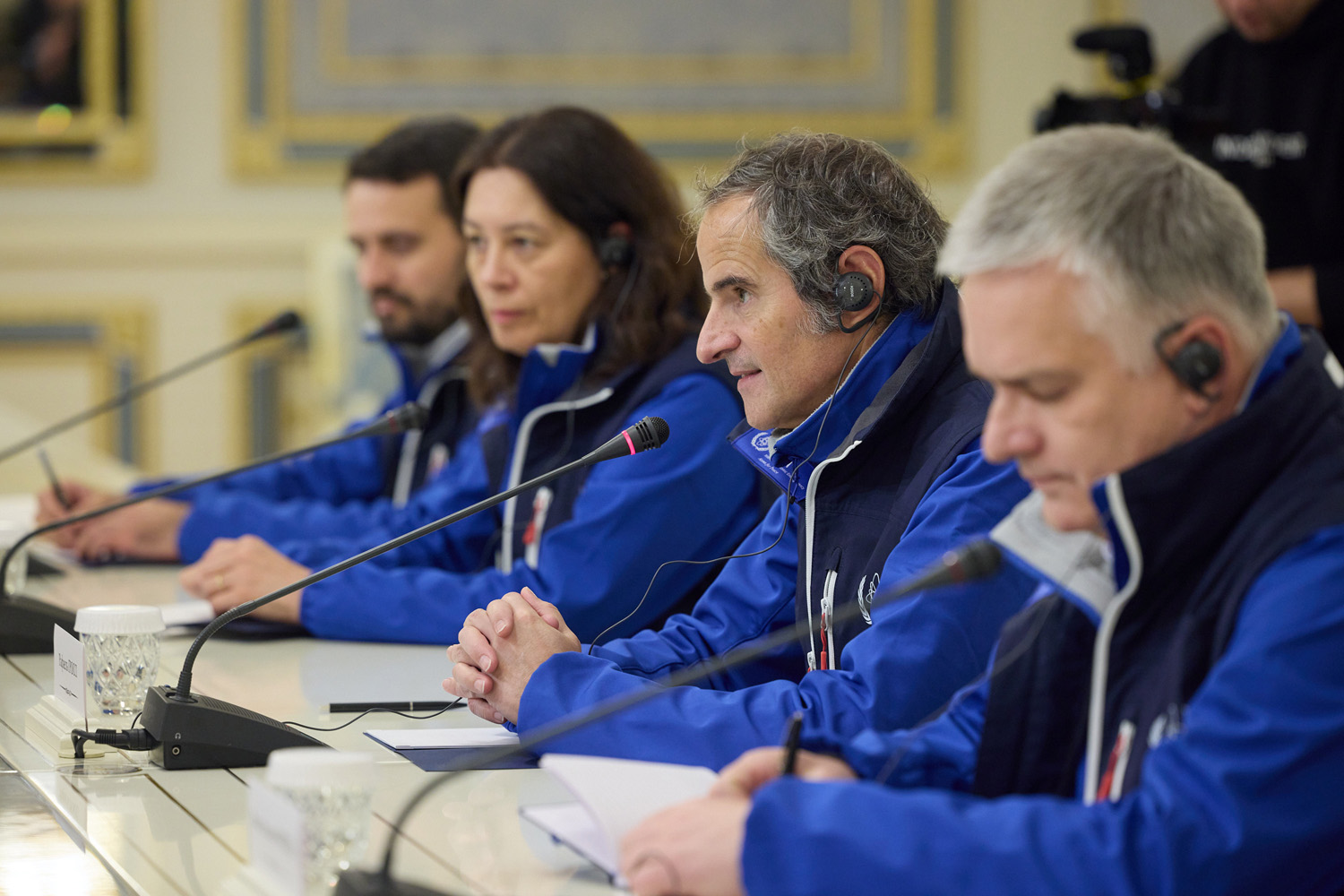
IAEA representatives at a meeting with Volodymyr Zelenskyy. Photo: Presidential Office.
Ukraine has repeatedly requested the inclusion of UN military experts in the IAEA mission. Only they have the mandate and authority to document shelling incidents; only they can provide an assessment of events. IAEA specialists lack such a mandate; hence, they cannot determine who initiated the fire and make official statements. However, this request has not been fulfilled.
Can the IAEA guarantee the safety of Ukrainian nuclear power plants?
Despite the war against Ukraine, extensive international sanctions, and other forms of pressure, Russia remains a member of the IAEA and holds certain influence over its decisions. Like other international organizations, the agency operates effectively when member countries collectively agree on specific arrangements. It’s futile to expect a government that disagrees with these agreements to adhere to them.
We can and should strive to have Russian citizens excluded from leadership positions and disconnected from international aid programs. It’s hard to imagine a mechanism that would compel Russia to fulfil its obligations. At most, the IAEA can isolate it.
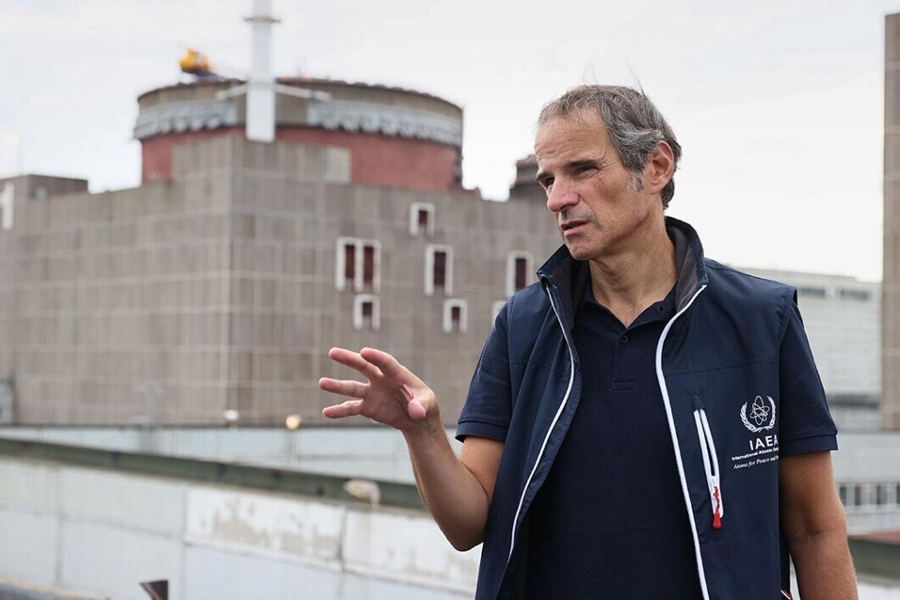
Rafael Grossi at ZNPP. Photo: Slovo i dilo.
The IAEA’s main objective is to prevent the use of radioactive materials for weapon production. Accordingly, the agency conducts most of its visits and inspections to ensure that radioactive materials are stored under proper conditions and are not easily susceptible to theft. However, they are powerless when it comes to safeguarding nuclear power plants from real threats. Similar to other international structures, it is practically impossible to reach collective decisions criticizing Russia, as it is one of the participants and can block voting on specific resolutions.
The widespread perception of the IAEA as an organization capable of influencing member countries’ policies in nuclear energy and security does not align with reality. Also, one should expect the agency to refrain from taking real actions and sanctions against countries that fail to comply with their obligations. The IAEA merely observes compliance with agreements and identifies violations but lacks concrete instruments to influence countries that do not meet requirements. The agency’s effectiveness depends on the voluntary cooperation of member states, and when such cooperation is absent, the IAEA cannot affect the situation. Cases similar to North Korea’s refusal to admit IAEA inspectors or Iran’s denial of access to military zones underscore this limitation.
Ultimately, the responsibility for addressing nuclear non-proliferation issues, safeguarding nuclear materials, and ensuring nuclear security is assigned to member states and the United Nations. These organizations have the right to employ political and economic response mechanisms to violations. The IAEA, on the other hand, serves as an observer and consultant that lacks the strength and authority to genuinely influence countries’ nuclear security policies.
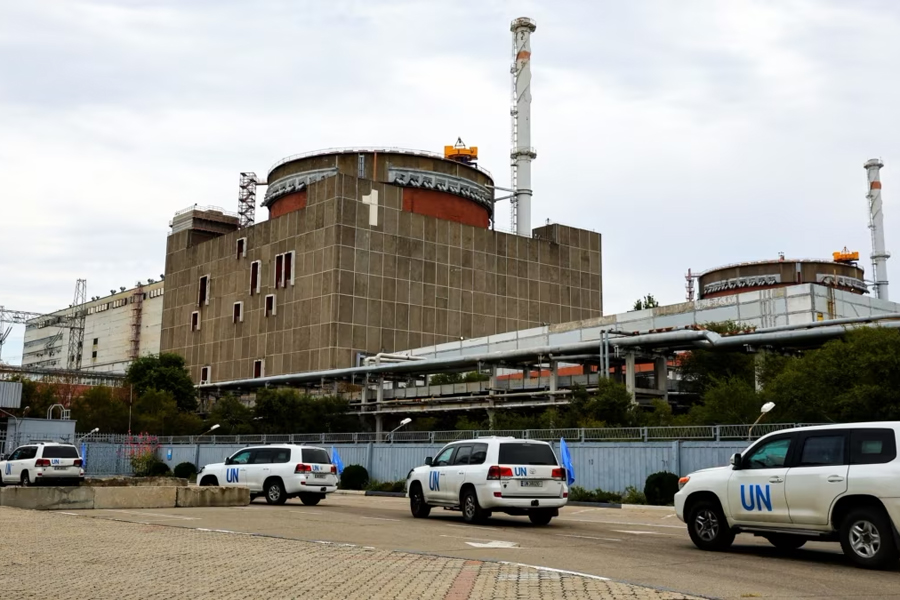
IAEA mission vehicles on the territory of ZNPP. Photo from open sources.
The situation related to the Zaporizhzhia NPP constitutes a dangerous precedent that calls for a reevaluation of the international security system. Real response and accountability in such threats must be ensured. The UN does not exhibit significant influence in such situations, which could indicate limitations in its organizational structure and a need for further reforms.
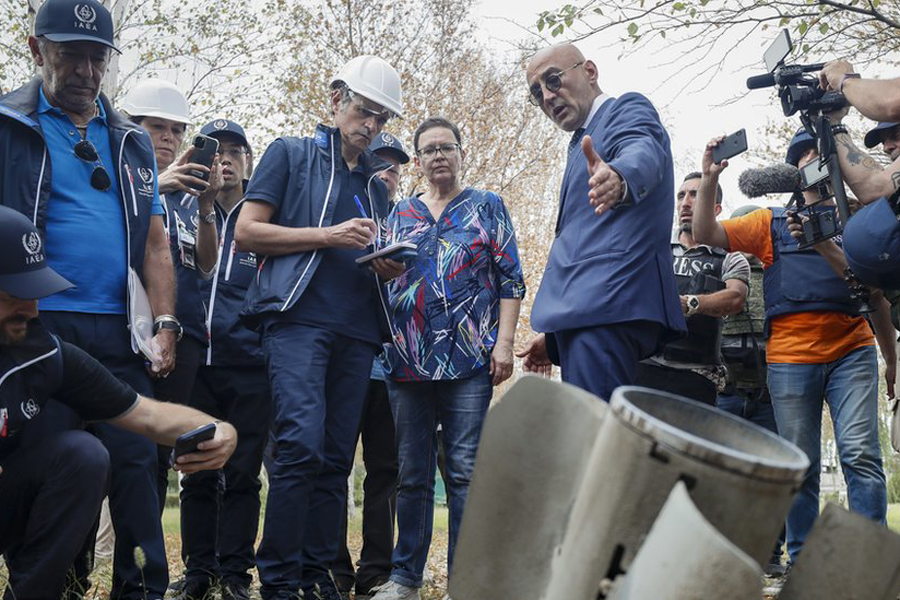
Russians show the IAEA mission the aftermath of the Russian shelling. Photo: ERA.
To prevent nuclear terrorism and ensure nuclear security, the international community needs to enhance cooperation, share information and technologies, and utilize political and economic response mechanisms to violations. Examining the Zaporizhzhia NPP situation should serve as a stimulus for further improvement of the international security system.

